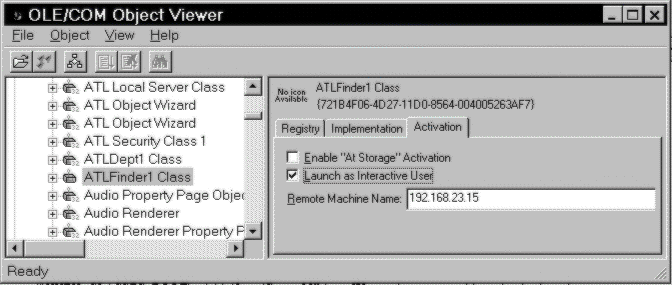
Machine A is the client machine with the following software configuration:
On this machine, we'll set up the Aberdeen & Wilshire Calendar ActiveX control. This will require the pre-installation of the
control and required associated files on the client station.Vccalc1.ocx
To pre-install the
file on machine A, you may use the following procedure:Vccalc1.ocx
Regsvr32.exe\Windows\SystemVccalc1.ocx\Windows\SystemVccalc1.ocx\Windows\SystemDUMPBIN/IMPORTS VCCALC.OCXMfc42d.dllMfco42d.dllMsvcrtd.dllregsvr32 VCCALC1.OCX
The next thing that you need to do on machine A is set up DCOM class linkage. We know that
will instantiate an ATLFinder object during its operation, therefore we'll need to pre-wire this class (through its class ID) to a remote machine. Recall that we could have indeed hard-coded this into Vccalc1.ocx
using ATLFinder.exe
, but we'll take advantage of DCOM support for legacy applications in our experiment. CoCreateInstanceEx()
The easiest way to do this, again, is with the assistance of the indispensable
utility. Follow these steps:Oleview.exe
atl.dll\Windows\Systemregsvr32 atl.dllATLFinder.exeATLFinder /RegServerATLFinder.exe
Running
will prepare the registry with information about the ATLFinder object. The actual ATLFinder.exe
isn't required on this node, so we remove it after it's completed the job of setting up the registry entries. While ATLFinder adjusted the registry, it also inserted the location of the ATLFinder.exe
file under the .EXE
key. We need to remove this and point it at the remote machine B. Start up \HKEY_CLASSES_ROOT\<clsid>\LocalServer32
. Select All Objects on the left pane, and find the ATLFinder1 Class entry and select it. On the right pane, select the Implementation tab. Select the Local Server subtab, and clear out the Path to Implementation edit. This will clear up the associated registry key. Next, select the Activation tab. The pane will look like this:Oleview.exe

Select the Launch as Interactive User check box and enter in the IP address of machine B in the Remote Machine Name edit. This tells the DCOM runtime to find a server for the ATLFinder1 class on the remote machine. When DCOM tries to launch the server remotely, the identity used will be that of the currently logged on user in Windows 95.
The Enable ‘At Storage’ Activation setting is specifically used in ActiveX document and/or Moniker binding scenarios where the desired operation is to 'start the object server on the node wherever the persistent data file of the object instance is stored'. This can be a powerful, albeit confusing, mechanism for starting object servers remotely. Essentially, it will allow for the activation of a DCOM object server remotely if the client has a pathname (e.g.
) to a file containing the persistent data used by the class (in this case, the server will be started on the \\System5\User\Doe\Mper.dat
machine). The network filesystem is used as a type of persistent object instance store, and a UNC pathname is used to access and reactivate persisted object instances. \\System5
In actual deployment and production scenarios, performing the above setup on every client machine would be impossible. The ideal situation is to have the entire procedure automated when the user reaches a web page containing the
Vccal1.ocxCoGetClassObjectFromURL().CABA
.CAB.INFWinVerifyTrust()Bear in mind, however, even if a
.CABVccal1.ocx